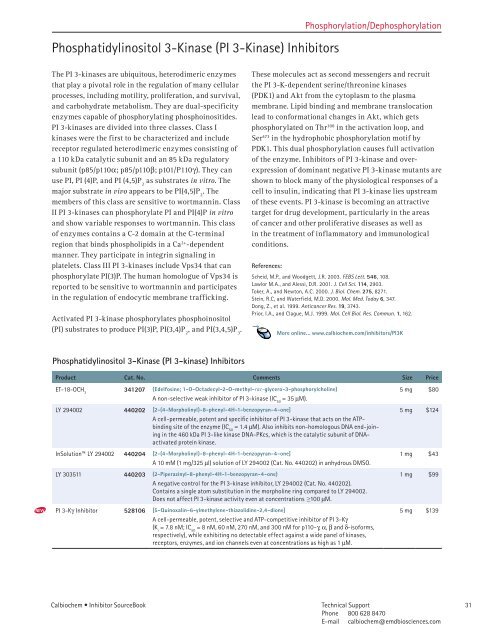Inhibitor SourceBook™ Second Edition
Inhibitor SourceBook™ Second Edition
Inhibitor SourceBook™ Second Edition
Create successful ePaper yourself
Turn your PDF publications into a flip-book with our unique Google optimized e-Paper software.
Phosphatidylinositol 3-Kinase (PI 3-Kinase) <strong>Inhibitor</strong>s<br />
The PI 3-kinases are ubiquitous, heterodimeric enzymes<br />
that play a pivotal role in the regulation of many cellular<br />
processes, including motility, proliferation, and survival,<br />
and carbohydrate metabolism. They are dual-specificity<br />
enzymes capable of phosphorylating phosphoinositides.<br />
PI 3-kinases are divided into three classes. Class I<br />
kinases were the first to be characterized and include<br />
receptor regulated heterodimeric enzymes consisting of<br />
a 110 kDa catalytic subunit and an 85 kDa regulatory<br />
subunit (p85/p110a; p85/p110b; p101/P110g). They can<br />
use PI, PI (4)P, and PI (4,5)P 2 as substrates in vitro. The<br />
major substrate in vivo appears to be PI(4,5)P 2 . The<br />
members of this class are sensitive to wortmannin. Class<br />
II PI 3-kinases can phosphorylate PI and PI(4)P in vitro<br />
and show variable responses to wortmannin. This class<br />
of enzymes contains a C-2 domain at the C-terminal<br />
region that binds phospholipids in a Ca 2+ -dependent<br />
manner. They participate in integrin signaling in<br />
platelets. Class III PI 3-kinases include Vps34 that can<br />
phosphorylate PI(3)P. The human homologue of Vps34 is<br />
reported to be sensitive to wortmannin and participates<br />
in the regulation of endocytic membrane trafficking.<br />
Activated PI 3-kinase phosphorylates phosphoinositol<br />
(PI) substrates to produce PI(3)P, PI(3,4)P 2 , and PI(3,4,5)P 3 .<br />
Phosphatidylinositol 3-Kinase (PI 3-kinase) <strong>Inhibitor</strong>s<br />
Calbiochem • <strong>Inhibitor</strong> SourceBook<br />
Phosphorylation/Dephosphorylation<br />
Product Cat. No. Comments Size Price<br />
ET- 8-OCH 3 341207 (Edelfosine; 1-O-Octadecyl-2-O-methyl-rac-glycero-3-phosphorylcholine)<br />
A non-selective weak inhibitor of PI 3-kinase (IC 50 = 35 mM).<br />
These molecules act as second messengers and recruit<br />
the PI 3-K-dependent serine/threonine kinases<br />
(PDK1) and Akt from the cytoplasm to the plasma<br />
membrane. Lipid binding and membrane translocation<br />
lead to conformational changes in Akt, which gets<br />
phosphorylated on Thr 308 in the activation loop, and<br />
Ser 473 in the hydrophobic phosphorylation motif by<br />
PDK1. This dual phosphorylation causes full activation<br />
of the enzyme. <strong>Inhibitor</strong>s of PI 3-kinase and overexpression<br />
of dominant negative PI 3-kinase mutants are<br />
shown to block many of the physiological responses of a<br />
cell to insulin, indicating that PI 3-kinase lies upstream<br />
of these events. PI 3-kinase is becoming an attractive<br />
target for drug development, particularly in the areas<br />
of cancer and other proliferative diseases as well as<br />
in the treatment of inflammatory and immunological<br />
conditions.<br />
References:<br />
Scheid, M.P., and Woodgett, J.R. 2003. FEBS Lett. 546, 08.<br />
Lawlor M.A., and Alessi, D.R. 200 . J. Cell Sci. 114, 2903.<br />
Toker, A., and Newton, A.C. 2000. J. Biol. Chem. 275, 827 .<br />
Stein, R.C, and Waterfield, M.D. 2000. Mol. Med. Today 6, 347.<br />
Dong, Z., et al. 999. Anticancer Res. 19, 3743.<br />
Prior, I.A., and Clague, M.J. 999. Mol. Cell Biol. Res. Commun. 1, 62.<br />
More online... www.calbiochem.com/inhibitors/PI3K<br />
LY 294002 440202 [2-(4-Morpholinyl)-8-phenyl-4H-1-benzopyran-4-one]<br />
A cell-permeable, potent and specific inhibitor of PI 3-kinase that acts on the ATP-<br />
binding site of the enzyme (IC 50 = .4 mM). Also inhibits non-homologous DNA end-joining<br />
in the 460 kDa PI 3-like kinase DNA-PKcs, which is the catalytic subunit of DNAactivated<br />
protein kinase.<br />
InSolution LY 294002 440204 [2-(4-Morpholinyl)-8-phenyl-4H-1-benzopyran-4-one]<br />
A 0 mM ( mg/325 ml) solution of LY 294002 (Cat. No. 440202) in anhydrous DMSO.<br />
LY 3035 440203 (2-Piperazinyl-8-phenyl-4H-1-benzopyran-4-one)<br />
A negative control for the PI 3-kinase inhibitor, LY 294002 (Cat. No. 440202).<br />
Contains a single atom substitution in the morpholine ring compared to LY 294002.<br />
Does not affect PI 3-kinase activity even at concentrations ≥ 00 mM.<br />
N PI 3-Kg <strong>Inhibitor</strong> 528106 [5-Quinoxalin-6-ylmethylene-thiazolidine-2,4-dione]<br />
A cell-permeable, potent, selective and ATP-competitive inhibitor of PI 3-Kg<br />
(K i = 7.8 nM; IC 50 = 8 nM, 60 nM, 270 nM, and 300 nM for p 0-g, a, b and d-isoforms,<br />
respectively), while exhibiting no detectable effect against a wide panel of kinases,<br />
receptors, enzymes, and ion channels even at concentrations as high as mM.<br />
5 mg $80<br />
5 mg $ 24<br />
mg $43<br />
mg $99<br />
5 mg $ 39<br />
Technical Support<br />
Phone 800 628 8470<br />
E-mail calbiochem@emdbiosciences.com<br />
3



